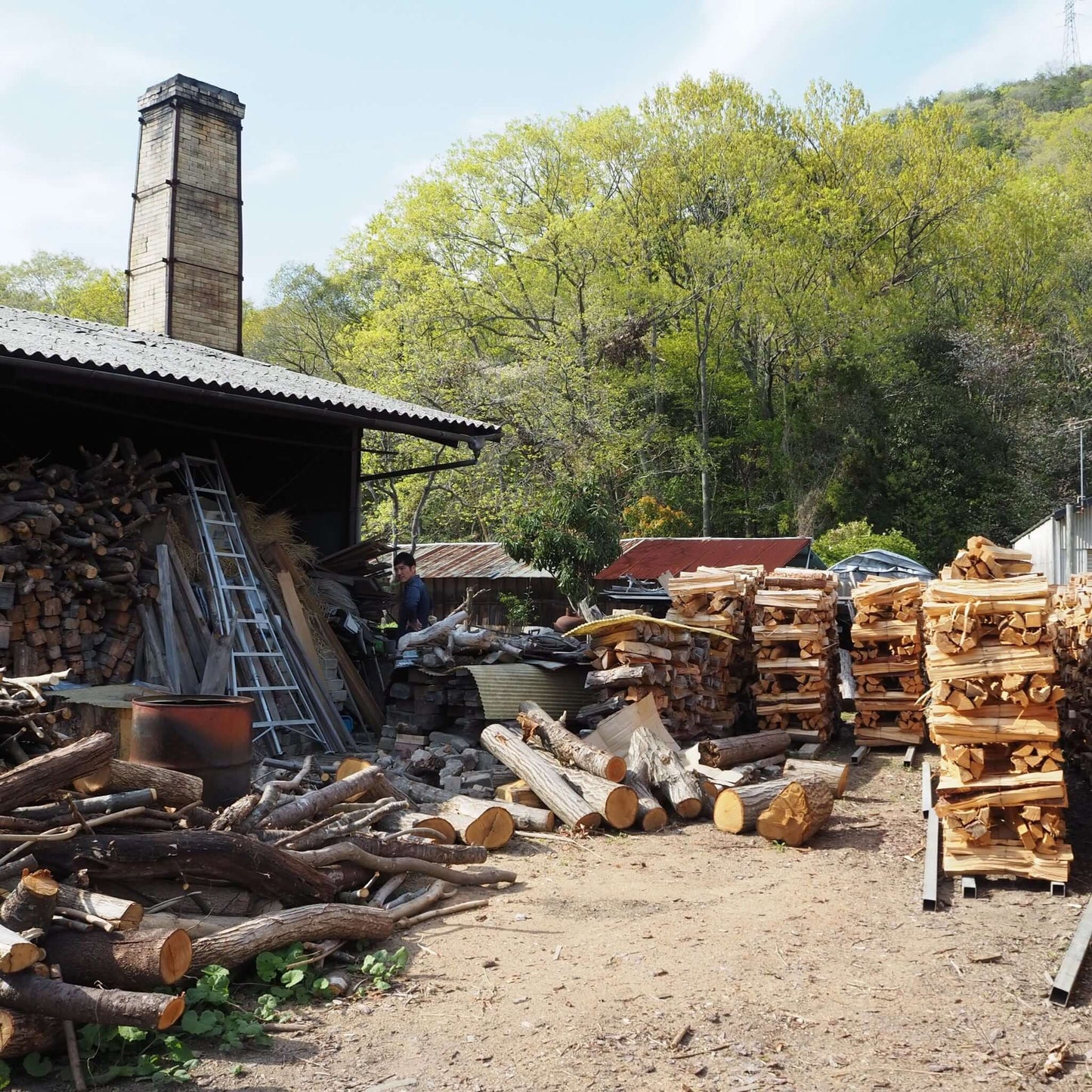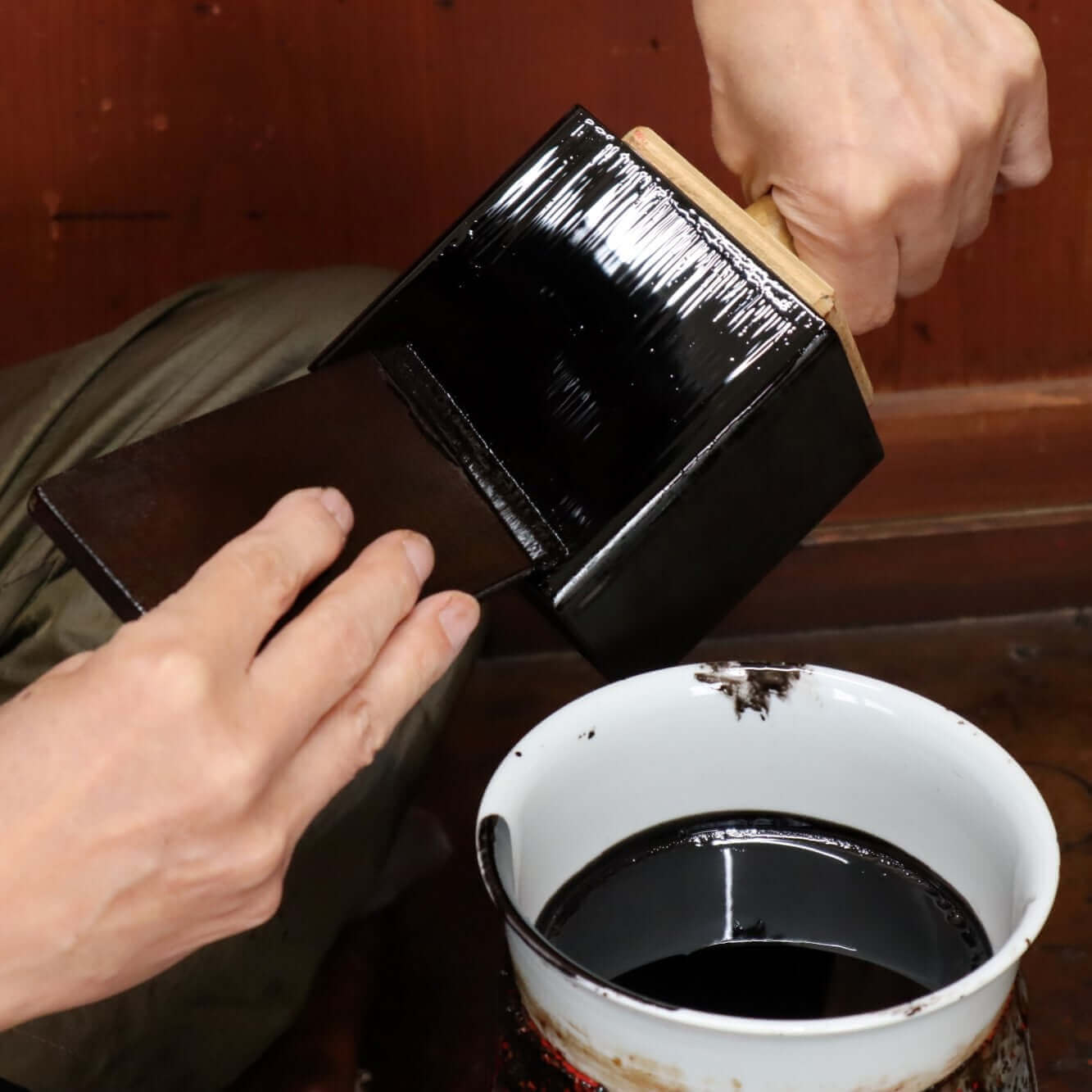This is a Sangiri teapot from Mori Ichiro's studio. This teapot is made from Bizen clay in the shape of a horizontal jar, which is one of the standard shapes of Chinese teapots. It has just the right capacity for brewing Chinese or Taiwanese tea. It is packaged as a gift combining Echizen lacquerware and furoshiki.
Mr. Mori majored in sculpture, and has excellent sculpting skills, such as beautiful and powerful shapes. While based on tradition, he is exploring new styles of Bizen ware.
(Brief biography of Mori Ichiro)
Born in 1981 into the Mori family, a Bizen ware kiln manufacturer.
Graduated from the Tokyo University of the Arts Graduate School of Fine Arts, Department of Sculpture in 2008
2009 Drift Wood Sculpture Festival (Taipei/Taiwan)
2011 Sculpture 575/ (Taipei/Taiwan)
2015 THE POWER OF BIZEN (Daiwa Anglo-Japanese Foundation, Kigbeare studio & gallery/UK)
Bizen ware is pottery that is expressed with earth and fire. It is said that preparing clay accounts for more than half of the work in Bizen ware, so preparing clay is an important task.
Bizen has soils of various colors and properties, and artists search for soil that suits their work. Bizen soil has coarse particles, making it difficult to make complex shapes like teapots. For this reason, Bizen ware tea utensils are mostly matcha bowls and houhin, but very few teapots.
Bizen soil contains iron. According to a study on Bizen ware kiln changes (the 3rd Okayama Studies Symposium, by Yamaguchi Kazuhiro, Okayama University of Science), the iron content of Bizen clay is about 2-3%.
This iron binds with tannins, the bitter component of tea. Therefore, tea brewed in a teapot made from Bizen clay is less bitter and has a smoother taste.
WE once held a tasting event in Hong Kong using Bizen ware teapots. The tasting was lively, with many participants saying that when brewing Pu-erh ripe tea, the tea tasted especially smooth. Since taste perception differs from person to person, it is difficult to make a general statement, but we do feel that it does result in a smoother taste.
We feel that Bizen teapots make the tea taste smoother than Tokoname red clay teapots. The iron content of Tokoname vermilion clay is about 5-6%, while that of Bizen clay is about 2-3%, so if we look at the iron content alone, Tokoname vermilion clay seems to bind more easily with tannins.
Bizen clay has large particles and has voids in the clay, so it is thought to absorb more astringency. The same mechanism applies to Chinese vermilion and purple clay teapots. The effect seems to be greater for Bizen clay, as the particles are larger.
Bizen ware does not have patterns painted on the vessels, but the patterns are created by the flow of the flames that change inside the kiln and the technique. The way the flame hits the vessel changes depending on where it is placed, such as near the entrance to the kiln, in a high place, or near a corner. Each vessel is made by relying on the natural flames, and no two vessels are the same.
"Sangiri" is a traditional Bizen ware technique characterized by a pale gray or brown color. At the end of the firing process, charcoal is put into the kiln through a side hole and the vessel is covered with charcoal. Because charcoal and ash partially cover the surface of the vessel, different patterns are created in the areas where the flame hits and the areas where it does not.
In the past, there was a partition called a "san" inside the kiln for Bizen ware, and gray or brown vessels were fired near this partition, which is why it is called this.
Bizen pottery is characterized by the texture and feel of natural clay. While the energy of the flame can be felt from the same Bizen ware's Hidasuki, the silence of the earth and forest can be felt from the Sangiri. This teapot is a fusion of Chinese tea culture and the nature of Bizen, expressing the traditional Chinese teapot called a horizontal pot with Bizen clay.
To store the teapot, we custom-ordered a lacquered box from Ootoshi Lacquerware, a long-established Echizen lacquerware studio that has been in business for four generations. It is lacquered using real lacquer and the traditional process of Echizen lacquerware. It takes three months to complete because it is made by hand one by one.
The surface of the lacquered box has a soft thickness and a modest luster that is unique to lacquer. Lacquer boxes are not only used to store teapots, but are also beautiful works of art and can be used to decorate a room. Wrapping them in a traditional furoshiki cloth gives them a more Japanese and cultural look.
Potter: ICHIRO MORI Studio
Firing: Wood-fired kiln
Size: Total length 11.5cm (including handle and spout), body diameter 8cm, height 8cm
Capacity: 180ml
Weight: Approximately 140g
Notes: There is a hole at the top of the lid knob. Since it is handmade, each piece is different.
Because the soil particles are coarse, it is difficult to stop the hot water even if you press the hole at the top of the lid. When pouring water, do not tilt the teapot vertically, but pour slowly to ensure smooth pouring.
<Lacquerware box>
Maker: Ootoshi Lacquerware (Echizen Lacquerware)
Size: Length 10.8cm, Width 10.8cm, Height 11.5cm
Weight: 230-260g
Materials: Lid - Shina plywood / Body - Hiba wood / Paint - Natural lacquer
Notes: Handmade in Fukui Prefecture. All sides are painted with black lacquer.
<Furoshiki>
Maker: Miyai Co., Ltd.
Materials: 100% cotton
Weight: Approximately 50g
Notes: Manufactured in Kyoto Prefecture. You can choose the color of the furoshiki, green or brown.
*Bizen ware
Bizen ware is pottery made in Bizen City, Okayama Prefecture. Production of Bizen ware began around the end of the Heian period, about 800 years ago. Bizen ware is fired at high temperatures of 1200-1300℃, and because it is sturdy, many pots and jars were initially made. Bizen ware is loved by tea masters for its unique clay texture, and since the Muromachi period (1338-), much pottery for the tea ceremony has been made.
Bizen ware is characterized by the fact that the clay is not glazed, but is fired as is, and the beauty of the patterns that make use of the taste of the clay. Bizen ware is mainly fired in wood-fired kilns. The fuel is mainly pine trees, and the pottery is fired for about two weeks.
There are two types of clay: rice field clay, which is mainly taken from rice paddies, and mountain clay, which is taken from the mountains. The beautiful patterns unique to Bizen ware are created with clay rich in iron, and the clay taste of each artist is created by the mixture of clay.
When Bizen ware gets wet, the color becomes brighter, and the color changes with long use. This change is a major attraction, so you can enjoy using the vessel and watching it grow.
* Echizen lacquerware
The origin of Echizen lacquerware dates back to about 1,500 years ago. Before Emperor Keitai, the 26th Emperor of Japan, ascended to the throne, he ordered a lacquer craftsman from Echizen to repair his crown. The lacquer craftsman repaired the crown with lacquer and presented a lacquered bowl to the Emperor. The production of lacquerware was encouraged, and lacquerware production began in Katayama village, Sabae City, Fukui Prefecture.
Echizen has many lacquer trees, and it is said that at its peak it produced half of the lacquer in the country. When Nikko Toshogu Shrine in Tochigi Prefecture was being built, the Tokugawa Shogunate ordered lacquer craftsmen in Echizen to collect lacquer.
After the Muromachi period, lacquered bowls became widely used in Buddhist ceremonies. At the end of the Edo period, maki-e craftsmen were invited from Kyoto to introduce the technique of maki-e. The technique of chinkin was adopted from Wajima in Noto, and Echizen lacquerware became not only durable but also decorative.
From the middle of the Meiji period, trays and stacked boxes called "kakumono" (square objects) began to be made. The square bowls used for Zaru Soba and sushi geta (wooden clogs) are also square objects. Incidentally, bowls are called "marumono" (round objects). Square objects require more lacquering processes than round objects, and the lacquer tends to accumulate on the corners, making it difficult to achieve a smooth and beautiful lacquer surface. Ootoshi Lacquerware is a workshop that has been in business for four generations and specializes in square objects.







































